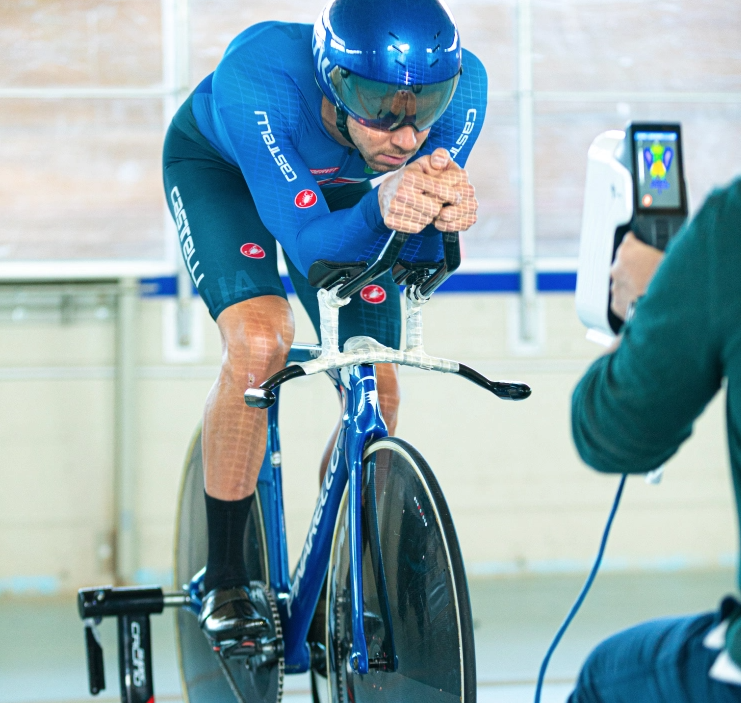The Italian national cycling team is preparing for the Tokyo Olympics. They use a handheld Calibry 3D scanner by a Russian manufacturer Thor3D to improve the aerodynamics of their bicycles.
The brands Pinarello and Hardskin asked 3DiTALY (Thor’s 3D official partner in Italy) to digitize the bicycles using the Calibry 3D devices. The results were used to adjust the aerodynamics of the bikes..
Calibry 3D scanning
The Calibry 3D scanners were shown at TCT Asia in 2019. The handheld devices can handle medium-sized and larger objects, as well as provide full-body human scans. The Calibry machines were the first scanners by the company to use its proprietary camera solutions.
These cameras can capture textures and offer a resolution of 2.5 megapixel. The scanning speed is 3,000,000 points per second. The accuracy is 0.1 mm, and the devices feature touchscreens for improved controls and monitoring.
Thor3D partnered with software developers nPowerSoftware and Pixologic to provide new bundles for their devices.That was in the beginning of 2020.
Later that year, the mini version of the Calibry device was launched. Made to handle smaller objects and targeting education, medicine, as well as art fields, the machines kept technical specs of the larger variants but had smaller sizes and improved prevision. The level of accuracy was 0.07 mm and pixel resolution reached 0.15 mm. The depth of field was also improved: 180-300 mm.
The scanners come with a proprietary software solution named Calibry Nest. The latest versions are 3.3 and 3.4, each offering a wide range of updates, including new device support and faster texturizing times, as well as other added and improved functionalities.

Using the Calibry scanners for aerodynamics improvements
Speed matters the most for professional cyclists. Even the fractions of a second can play a significant role. Pnarello and Hardskin acted together to figure out how to improve the speed and aerodynamic efficiency of Italian athletes prior to the Tokyo Olympics.
3DiTALY provided digital scans of the bicycles in February 2021. The athletes riding the bikes were also digitized. The scanning was done at the Velodrome of Montichiari in the province of Brescia.
The Calibry 3D provided the scans and helped to figure out the most aerodynamic riding position during the warm-ups and races. The athletes wore full sportswear to make the experience the closest to the real races.
Scanning took just 2 minutes, after that the Pinarello’s engineers worked with data for the studies. All of the necessary data was used to find the perfect position to increase the aerodynamics efficiency. The custom-made handlebar was also designed afterwards to fit perfectly to the arms of the athletes. .

3D printing and the Olympics
Italian cyclists are not the first team to use additive manufacturing for their gains and savings.For example, Jamaican runner Shelly-Ann Fraser-Pryce used 3D printed running shoes at the Rio de Janeiro Olympics. Adidas together with 3D printer manufacturer Carbon also designed the 4DFWD midsole running shoes that were used by various athletes at the Tokyo Olympics.
Cycling sports also had prior experience with 3D printing. For example, the French Cycling Federation also used custom handlebars for improved aerodynamics at the Rio games in 2016.
Similarly, engineering firm Renishaw designed a new track bike for the Great Britain Cycling Team prior to the Tokyo Olympics. They partnered with Lotus and Hope Technology to design the bike that used 3D printed parts, offering lighter weight and new design.
And the usage of additive manufacturing is not strictly limited to the athletes and sportswear at the Olympics. Following the request of ICO and Tokyo Olympic Committee, Procter & Gamble 3D printed almost a hundred reusable podiums for the Tokyo Olympics with the plastic recycled from thousands locations in Japan and featuring olympic logo made from recycled aluminum as well.
